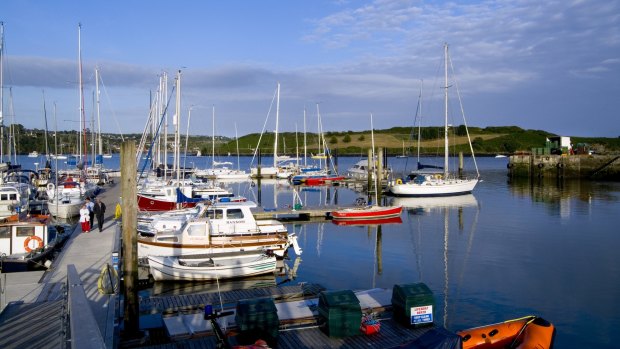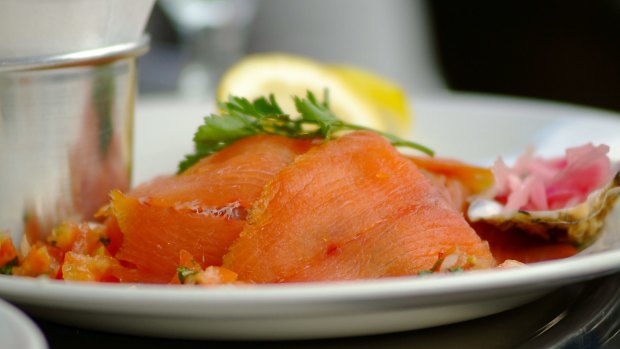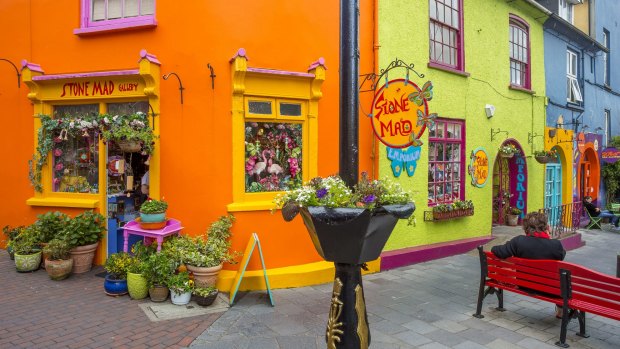By Steve McKenna

Kinsale's pretty harbour.Credit: Tourism Ireland
With its pretty harbour dotted with yachts and quaint old centre threaded with colourful Georgian and Victorian buildings, Kinsale is a contender for Ireland's most photogenic port town. It's certainly one of its "foodiest".
Tucked amid a tangle of narrow streets is a string of enticing restaurants and gastropubs, many of which belong to the Good Food Circle, a collective that was founded here in the 1970s, with designs on making Kinsale Ireland's capital of gastronomy.
The "circle", which organises the annual Kinsale Gourmet Festival, now comprises 11 eateries, all specialising in dishes packed with seasonal produce sourced from the rivers, ocean and gorgeous green hills and fields edging this historic town, 30 kilometres south of Cork.

If you want the quintessential Irish pub experience, Kinsale has oodles of possibilities - but there's plenty of trendy cosmopolitan eateries too. Credit: Tourism Ireland
A stand-out destination on our nine-day Countryside of the Emerald Isle tour, Kinsale is a magnet for Irish and international visitors alike. It sits at the southern-most point of the Wild Atlantic Way, which was officially launched in 2014 and is billed as the world's longest defined coastal touring route, winding 2600 kilometres north from Kinsale to the Inishowen Peninsula in County Donegal.
With two nights in Kinsale, we have time to savour the local sights, scenic harbourside walks and tasty cuisine (we each have a Good Food Circle voucher that goes towards paying our bills).
Tantalising options include fine-dining affair Finns' Table, Fishy Fishy – which is run by Martin Shanahan, one of Ireland's top seafood chefs – and Sidney's Bar & Brasserie inside Actons Hotel, our handsome four-star base, which is set in landscaped gardens and has lovely harbour views from many of its 77 rooms (including mine).

Kinsale is a contender for Ireland's most photogenic port town.Credit: Tourism Ireland
For an evening meal, I can recommend The Supper Club, a few doors down from Finns' Table on Main Street, a charming stretch lined with bookstores, boutiques and traditional family businesses. The Supper Club has a cocktail bar vibe – drinks are mixed up at a bar atmospherically lit with glowing red ceiling lamps. The adjoining wood-panelled dining area has eye-catching artwork, notably a painting that resembles a scene, and characters, from a James Joyce novel.
Tempted with a choice of daily specials and a menu that has a French touch and includes baked camembert and monkfish with beurre blanc sauce, I plump for a pot of local Oysterhaven mussels in a chardonnay, garlic and fennel cream. It's delicious – not too salty – and served with thick slices of Guinness and treacle bread that is ideal for mopping up the sauce. The mains are even better, 24-hour beef short rib that crumbles at the touch of my fork. It comes with crunchy tenderstem broccoli, parsnip puree, rosemary and sea salt potatoes, and goes well, I find, with a velvety Malbec from Mendoza, Argentina.
If you want the quintessential Irish pub experience, Kinsale has oodles of possibilities. At venues such as the White House, you can tuck into seafood chowder and Irish stew with pints of Guinness (and drams of whiskey) as live "trad" music rumbles – a medley of foot-tapping beats, folksy singing and the sound of flutes, fiddles, tin whistles, guitars and banjos.
You'll also find trendy cosmopolitan eateries in town, such as Malay Kitchen, while Mediterranean flavours infuse some of the 30 stalls scattered in and around the old Temperance Hall at Wednesday's weekly farmers' market, where organic local fruit and veg, artisan cheeses and baked goodies are also sold.
One lunchtime, I pop to Dino's, Fishy Fishy's (easier-on-the-wallet) neighbour, and get takeaway, made-to-order, lightly-battered haddock and chips, which I munch by the harbour wall. The tide is out, a solitary red fishing boat is stuck in the mud and the gulls are nibbling about. It's an idyllic, peaceful scene and one I come to appreciate even more after a group walk with Barry Moloney, an affable and engaging tour guide who regales us with the local history.
We hear about the 1601 Battle of Kinsale where the English defeated a Catholic Irish-Spanish alliance to consolidate Protestant Queen Elizabeth I's grip on the Emerald Isle. Things looked promising for Gaelic chieftains such as Hugh O'Neill when an armada of 26 ships, led by Spanish commander Don Juan de Aguila, sailed into Kinsale harbour, carrying 4000 men, arms and ammunition. But just over three months later, the English cavalry quashed the Irish army in the boggy countryside around Kinsale and general Charles Blount forced the surrender of the Spanish, who had been under siege in the town for nearly 100 days.
It's thought that 7000 people died, mostly from disease and malnutrition, and the English victory had wider repercussions for Ireland and its ancient aristocracy. Land was seized from Gaelic lords, especially in Ulster, the province in what is now Northern Ireland. New Protestant settlers arrived from England and Scotland, usurping the Gaelic culture and sowing the seeds for the religious and socio-economic divides that would plague Ulster for generations. As Moloney points out, the after-effects of the battle reverberate today, not least with Brexit and the Irish border issue.
Kinsale's besieged old town walls were yanked down long ago, but by the harbourfront, there's a replica of a Spanish galleon mast erected for the battle's 400th anniversary. A few watering holes also pay homage, such as the Armada Bar on Market Street (a live music hotspot) and the hilltop Spaniard's inn. I pass it on the Scilly Walk, a beautiful coastal trail that links Kinsale and Summercove, a tiny village peppered with cottages and the vivid orange Bulman's Bar, where on this sunny afternoon, crowds sup pints al fresco, beside antique painted panels depicting Hugh O'Neill and Don Juan de Aguila.
Up the next hill is Charles Fort, a star-shaped late 17th-century fortress built during the reign of English King Charles II. From its ramparts, you can see where the harbour meets the Atlantic Ocean. Looming diagonally in the distance is the Old Head of Kinsale. On the ocean floor near this wave-lashed headland lies the dilapidated wreck of RMS Lusitania, a luxury British liner torpedoed by a German submarine in 1915. Many survivors were brought to Kinsale and the town's courthouse staged the inquest into the sinking, which resulted in the deaths of 1198 people and hastened the US's entry into World War I.
Moloney tells us that one of the best sellers in Kinsale's bookstores is Dead Wake: The Last Crossing of the Lusitania by American author Erik Larson. You'll get further insight into the disaster at the Lusitania Museum on Old Head – a 15-minute drive from Kinsale – and if you fancy a round of golf, hit the neighbouring Old Head Golf Links, one of Ireland's most exhilarating courses.
TRIP NOTES
MORE
TOUR
The Countryside of the Emerald Isle tour includes two nights in Kinsale and stays in Dublin, Killarney, the Aran islands and Ennis. It costs from $3349 a person, based on two sharing. See gocollette.com.au
Steve McKenna was a guest of Collette.
Sign up for the Traveller Deals newsletter
Get exclusive travel deals delivered straight to your inbox. Sign up now.